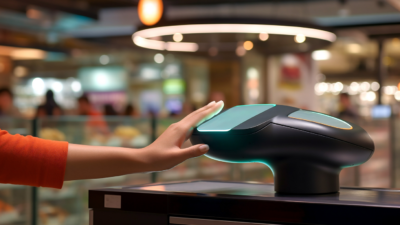If you think the holiday season starts earlier each year, you are right. Data shows that 40 percent of customers start shopping before Halloween, and retailers are meeting demand by stocking shelves with holiday items as early as September.
Black Friday sales are starting earlier, too. This uniquely American shopping holiday is becoming more of a marathon than a sprint. Amazon launched its “Countdown to Black Friday Deals” on November 3, and Walmart has been promoting “ten brand new online specials every day” since November 6. In a nod to the inertia of online retail, Cyber Monday is also expanding its role in the holiday shopping season.
Plus: Budget matters when Millennials become parents | An interview with Andrei Gog of Grosvenor Americas
Black Friday Shakeout
Black Friday is still the busiest shopping day of the year, with more than 87 million shoppers braving the cold and the crowds to score big discounts and one-of-a-kind deals. But Black Friday is facing stiff competition from Cyber Monday, which is expected to grow by 11 percent—nearly 3 times the growth of overall retail for the holidays. Black Friday sales fell at the same pace in 2014. More than 57 percent of U.S. consumers plan to shop on Cyber Monday, whereas only 35 percent plan to shop on Black Friday, according to Morepace Omnibus.
Also: Emerging Building Technologies and GSA | Bike commuting is on the rise. Is your office ready?
In recent years, retailers have fought to maintain the Black Friday sense of urgency by opening on Thanksgiving Day. A number of major department stores—including Walmart, Kmart, Sears, Macy’s, J.C. Penney, Target, Kohl’s, and many others—will be open for business on Thanksgiving Day, and they are opening earlier than ever.
Other big-name brands, however, are responding to a consumer-driven backlash and electing to stay closed on Thanksgiving Day, including Costco, Nordstrom, Bed, Bath and Beyond, Burlington Coat Factory, and many more. These retailers are giving their employees and their families a break, but they’re not really bucking any trends. A recent study shows that 36% of Americans “hate” holiday shopping.
REI, meanwhile, is taking a completely different approach. The store has decided to close its 143 stores on Thanksgiving and stay closed on Black Friday. The store will pay its 12,000 employees “to go out and play.” While the move seems counterintuitive, REI is not only tapping into a rising anti-consumerism sentiment, the store is also educating its customers about its mission, that “being outside makes our lives better.”
REI’s move may indeed signify the future of holiday marketing—and brand marketing in general. According to Advertising Age, REI’s move “signals a massive shift in the way companies are doing business and marketing themselves. The new reality is that as customers become more skilled at, and have better technology for, managing their many brand relationships, they will weed out or ignore companies that fail to sufficiently understand their needs and deliver value against them. This is the new consumerism — empowered, entrepreneurial and enabled.”
REI’s bold campaign already seems to be working. More than 800,000 people have already clicked on REI’s #OptOutside social media campaign.
Cyber Monday Upswing
Cyber Monday is the newest holiday shopping tradition. Online sales now generate 10 percent of all retail sales according to Forrester Research, and online sales increase to 15 percent of sales during the holiday shopping season. Adobe Digital Index predicts that Cyber Monday sales “will reach $3 billion for the first time” in 2015, “making it the largest single day for digital sales in history.” Online sales are picking up on Thanksgiving Day, too. They are expected to increase this year by 18 percent to $1.6 billion this year.
This proliferation of online and offline shopping traditions can be confusing for consumers. After all, isn’t the objective simply to find the biggest holiday savings? With so many competing promotions, how do consumers know which day—and which shopping channel—to choose? Well, it depends. The Christian Science Monitor has been tracking the expanding Black Friday season, and they created a handy scorecard to determine which day offered the best sales on any given product category. Their conclusion is that shoppers will find the best deals on Thanksgiving Day. Go figure.
Regardless of when they opt to shop, the savviest shoppers will engage in the newest holiday tradition: multi-channel shopping. Retailers are experiencing an “average of 135 percent year-over-year growth in sales from smart phones, and 86 percent via tablets.” Shoppers will be using their mobile devices to compare prices, check inventory, redeem coupons, and make purchases. Sales on iPhones alone are expected to drive 22 percent of online sales this holiday season.
Retailers are doing a better job of competing in the new era of shopping by presenting a more uniform brand presence across the different channels, creating smart shopping apps, improving their websites, offering timely “flash” or “deal-of-the-day” sales, merchandising on phones, providing in-store Wi-Fi to shoppers, and arming sales associates with smart devices to ensure consumers have the most up-to-the-minute information. All of these improvements are important, but the good news for retailers who haven’t caught up yet is that old-fashioned e-newsletters and loyalty programs are still the best way to get the consumer’s attention.
However retailers decide to do it—staying open or closed on Thanksgiving, maybe taking Black Friday off too, or loading up the deals for Cyber Monday—long-term, they will have to think about their brand marketing, and whether their actions are consistent with the brand they present. Customers have many ways to manage brand relationships, and many product choices to make.
Anjee Solanki is a Colliers delegate to MAPIC 2015, bringing an American perspective to the event happening November 18-20. The United States of America is MAPIC 2015’s Country of Honour. Follow Collier’s participation in MAPIC 2015 here.
Anjee continues to be an insatiable collector of all things retail. She’s a student of culture living next door to future shoppers, whose fleeting trends constantly change the retail landscape … driving retailers, landlords and developers crazy!

 Anjee Solanki
Anjee Solanki



 Nicole Larson
Nicole Larson